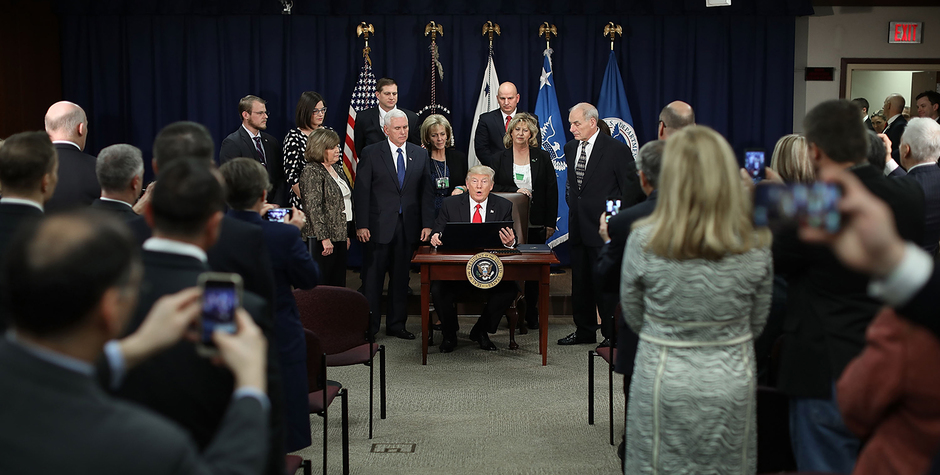What President Trump’s Executive Order on Immigration and Refugees Does and Does Not Do
On January 27, 2017, President Donald Trump entered an Executive Order that (1) suspends immigrant and nonimmigrant entry from 7 countries of particular concern; (2) pauses the entire U.S. refugee program for 120 days; and (3) prioritizes claims of people seeking refugee status due to religious persecution from countries where their religion is a minority. Importantly, nothing in the Order bans the entry of Muslims because they are Muslims or even identifies any particular religion or faith. Nor does the text of the Order violate the Constitution.
Here are the key points of the Order that impact immigration (not refugee acceptance):
- Relying on authority and procedures set forth in 8 U.S.C. 1187(a)(12), the Order suspends for 90 days the entry of people from “countries of particular concern” (currently Iran, Iraq, Syria, Sudan, Libya, Yemen and Somalia – all countries already designated as such during President Obama’s Administration). Sec. 3(c). Among other reasons, this 90-day pause is “to ensure that adequate standards are established to prevent infiltration by foreign terrorists or criminals.” Id. Certain diplomatic and governmental visa holders are exempted.
- The Order also requires a “determination of the information needed for adjudications and a list of countries that do not provide adequate information, within 30 days”; Department of State (DOS) to request such information from all foreign governments; and a recommendation of countries whose nationals should be prohibited entry due to a country’s failure to provide the information. Sec. 3.
And here are the key points of the Order that impact the United States’ acceptance of refugees:
- The Order pauses the U.S. Refugee Admissions Program (USRAP) for 120 days, during which the program will be reviewed “to determine what additional procedures should be taken to ensure that those approved for refugee admission do not pose a threat to the security and welfare of the United States, and shall implement such additional procedures.” Sec. 5(a).
- The Order also “prioritize[s] refugee claims made by individuals on the basis of religious-based persecution, provided that the religion of the individual is a minority religion in the individual's country of nationality.” Sec. 5(b).
- The Order suspends the acceptance of Syrian refugees as “detrimental to the interests of the United States” until “sufficient changes” have been made to the refugee program. Sec. 5(c).
- The Order sets the overall refugee cap at 50,000, Sec. 5(d), much closer to normal refugee limits before the Obama Administration dramatically increased the number last year. The President clearly has the discretionary authority to make this adjustment.
- The Order states the President’s policy that State and local jurisdictions should have “a role in the process of determining the placement or settlement in their jurisdictions of aliens eligible to be admitted to the United States as refugees.” Sec. 5(e).
- The Order also requires a “determination of the information needed for adjudications and a list of countries that do not provide adequate information, within 30 days”; DOS to request such information from all foreign governments; and a recommendation of countries whose nationals should be prohibited entry due to a country’s failure to provide the information. Sec. 3.
- The Order also grants the appropriate government agencies the authority to grant exceptions to these policies, on a case-by-case basis. This ensures that when exceptions need to be made, they can be.
The directives contained in the Order are closely tethered to discretionary powers vested in the Executive Branch and clearly fall within the President’s well-established constitutional and statutory authority. Again, the Order does not ban Muslim immigrants or refugees because they are Muslims and makes no reference to any specific religion. The Order simply pauses the entry of immigrants from certain unstable and terrorism-infested countries and refugees for the clearly articulated purpose of allowing time for needed improvements to the United States’ woefully inadequate immigration and refugee screening process. The countries whose nationals are implicated in the Order were already designated as countries of particular concern. This Order reflects much of what the ACLJ has called for and is a good “first step” in the difficult process of fixing our immigration and refugee system and the task of securing our nation.
As we have been advocating for the last fourteen months, a pause in the Syrian refugee program is needed in order to ensure that our vetting standards keep the American public – and refugees – safe. ISIS (the Islamic State) has specifically and publicly called for the infiltration of the refugee program – seeking to use refugees fleeing genocide as camouflage to enter the United States and inflict terror. ISIS has successfully inflicted carnage in this way throughout Europe. It cannot be allowed to happen here.
The ACLJ also continues to advocate for in-region safe zones as the best, quickest, and most humane and compassionate way to aid the millions of refugees fleeing jihadist genocide. We are encouraged by the fact that the Trump Administration is still pursuing this critical component of our 5-point refugee plan. In fact, President Trump secured the support of the King of Saudi Arabia this weekend for the implementation of safe zones.
We continue to strongly support the pause in the Syrian refugee program, the implementation of a verifiable vetting of refugees, the prioritization of religious minority refugees fleeing genocide and religious persecution, the implementation of safe zones in the region, and the destruction of ISIS.
For more information, please read:
